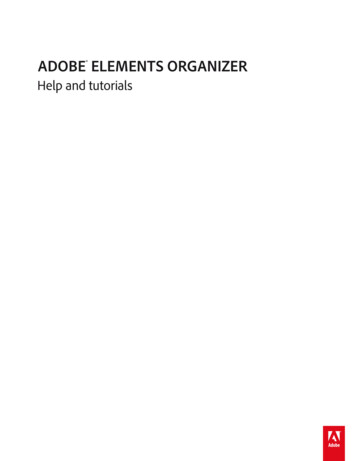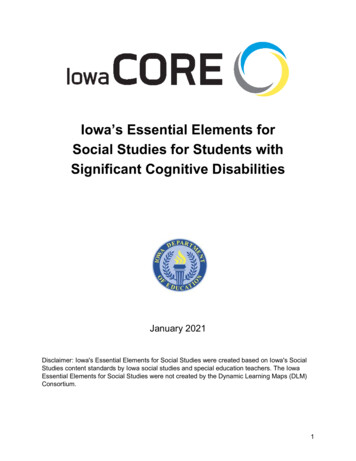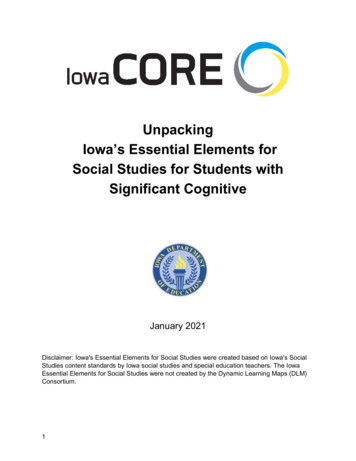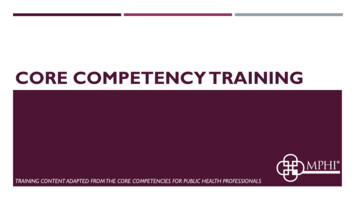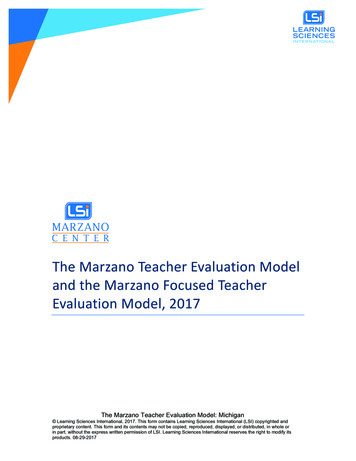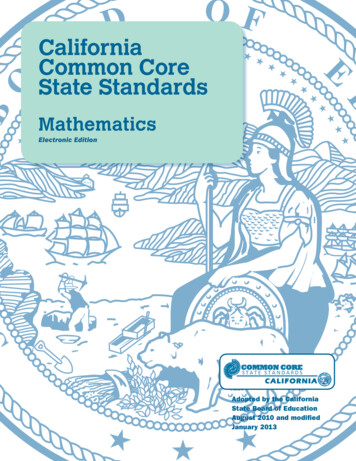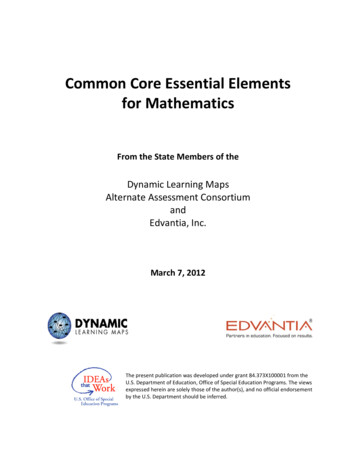
Transcription
Common Core Essential Elementsfor MathematicsFrom the State Members of theDynamic Learning MapsAlternate Assessment ConsortiumandEdvantia, Inc.March 7, 2012The present publication was developed under grant 84.373X100001 from theU.S. Department of Education, Office of Special Education Programs. The viewsexpressed herein are solely those of the author(s), and no official endorsementby the U.S. Department should be inferred.
Common Core Essential Elements andfor MathematicsTable of ContentsACKNOWLEDGEMENTS .ivINTRODUCTION . 1NCLB GUIDANCE. 2ACCESS TO INSTRUCTION AND ASSESSMENT . 3ACCESSING THE GENERAL CURRICULUM . 4GUIDANCE AND SUPPORT . 4RELATIONSHIP TO THE DYNAMIC LEARNING MAPS ASSESSMENT. 5SYSTEM ALIGNMENT. 6Levels of Performance . 6DOCUMENT ORGANIZATION . 8Directions for Interpreting Essential Elements . 8COMMON CORE ESSENTIAL ELEMENTSKindergarten Mathematics StandardsCounting and Cardinality . 9Operations and Algebraic Thinking. 11Number and Operations in Base Ten . 12Measurement and Data . 13Geometry . 14First Grade Mathematics StandardsOperations and Algebraic Thinking. 15Number and Operations in Base Ten . 18Measurement and Data . 20Geometry . 22Second Grade Mathematics Standards:Operations and Algebraic Thinking. 23Number and Operations in Base Ten . 25Measurement and Data . 27Geometry . 29Third Grade Mathematics Standards:Operations and Algebraic Thinking. 30Number and Operations in Base Ten . 33i
Number and Operations--Fractions . 34Measurement and Data . 36Geometry . 39Fourth Grade Mathematics Standards:Operations and Algebraic Thinking. 40Numbers and Operations in Base Ten . 42Number and Operations--Fractions . 44Measurement and Data . 47Geometry . 50Fifth Grade Mathematics Standards:Operation and Algebraic Thinking . 51Number and Operations in Base Ten . 53Number and Operations--Fractions . 55Measurement and Data . 59Geometry . 61Sixth Grade Mathematics Standards:Ratios and Proportional Relationships . 62The Number System. 64Expressions and Equations . 68Geometry . 71Statistics and Probability. 72Seventh Grade Mathematics Standards:Ratios and Proportional Relationships . 74The Number System. 76Expressions and Equations . 78Geometry . 80Statistics and Probability. 82Eighth Grade Mathematics Standards:The Number System. 85Expressions and Equations . 86Functions . 89Geometry . 91Statistics and Probability. 93High School Mathematics Standards: Number and QuantityThe Real Number System . 95Quantities. 96The Complex Number System . 97High School Mathematics Standards: AlgebraSeeing Structure in Expressions . 98Arithmetic with Polynomials and Rational Expressions . 100Creating Equations . 101ii
Reasoning with Equations and Inequalities . 102High School Mathematics Standards: FunctionsInterpreting Functions . 105Building Functions . 108Linear, Quadratic, and Exponential Models . 110Trigonometric Functions . 112High School Mathematics Standards: GeometryCongruence . 113Similarity, Right Triangles, and Trigonometry . 117Circles . 119Expressing Geometric Properties with Equations . 120Geometric Measurement and Dimension . 122Modeling with Geometry . 123High School Mathematics Standards: Statistics and ProbabilityInterpreting Categorical and Quantitative Data . 124Making Inferences and Justifying Conclusions . 126Conditional Probability and the Rules of Probability .128GLOSSARY AND EXAMPLES OF MATHEMATICS TERMS . 130GLOSSARY OF SPECIAL EDUCATION TERMS . 137BIBLIOGRAPHY OF DEVELOPMENT PROCESS. 141BIBLIOGRAPHY FOR MATHEMATICS CONTENT . Error! Bookmark not defined.143APPENDIX A: SEA/STAKEHOLDER DEMOGRAPHICSiii
ACKNOWLEDGEMENTS*For stakeholder demographics, See Appendix A.Edvantia FacilitatorsJan Sheinker, Sheinker Educational Services, Inc.Beth Judy, Director, Assessment, Alignment, and Accountability ServicesNathan Davis, Information Technology SpecialistKristen Deitrick, Corporate Communications SpecialistLinda Jones, Executive AssistantDynamic Learning Maps (DLM) Staff and ConsultantsNeal Kingston, Project DirectorAlan Sheinker, Associate Project DirectorLaura Kramer, Test Development LeadKarthick Palaniswamy, Technology Development LeadKelli Thomas, Mathematics Learning Map Team LeadCarrie Mark, English Language Arts Learning Map Team LeadPatti Whetstone, Research AssociateSue Bechard, ConsultantKaren Erickson, ConsultantChris Cain, ConsultantDynamic Learning Maps (DLM) Consortia StatesIowaKansasMichiganMississippiMissouriNew JerseyNorth CarolinaOklahomaUtahVirginiaWashingtonWest VirginiaWisconsiniv
Mathematics State Education Agency (SEA)/Stakeholder RepresentativesIOWASEA Representatives: Tom Deeter, Emily ThatcherStakeholders: Barbara Adams, John Butz, Laurel Cakinberk, Dagny FidlerKANSASSEA Representatives: Sidney Cooley, Debbie MatthewsStakeholders: DiRae Boyd, Teresa Kraft, Michele Luksa, Mona TjadenMICHIGANSEA Representatives: Linda Howley, Joanne WinkelmanStakeholders: Tamara Barrientos, Roula AlMouabbi, Brian Pianosi, Larry TimmMISSOURISEA Representatives: Lin Everett, Sara King, Jane VanDeZandeStakeholders: Sharon Campione, Emily Combs, Karen PaceNEW JERSEYSEA Representatives: Shirley Cooper, MaryAnn JosephStakeholders: Sue Burger, Tracey Lank, Katie SlaneNORTH CAROLINASEA Representative: Robin BarbourStakeholders: Ronda Layman, Janet SockwellOKLAHOMASEA Representatives: Jennifer Burnes, Amy DaughertyStakeholder: Christie StephensonUTAHSEA Representatives: Wendy Carver, Jennie DeFriezStakeholders: Lynda Brown, Kim Fratto, Lisa Seipert, Nicole Warrenv
VIRGINIASEA Representatives: John Eisenberg, Deborah WickhamStakeholders: Diane Lucas, Laura Scearce, Joyce Viscomi, Roslynn WebbWASHINGTONSEA Representatives: Debra Hawkins, Janice TornowStakeholders: Jeff Crawford, John DeBenedetti, Kirsten Dlugo, Angelita JaglaWEST VIRGINIASEA Representatives: Melissa Gholson, Beth CipolettiStakeholders: Wes Lilly, Melissa Mobley, Lisa New, Deena SwainWISCONSINSEA Representative: Brian JohnsonStakeholders: Amber Eckes, Rosemary Gardner, Mary Richards, Jeff Zieglervi
i
INTRODUCTIONThe Common Core Essential Elements (EEs) are linked to the Common Core StateStandards (CCSS) for Mathematics. A group of general educators, special educators, andcontent specialists from member states in the Dynamic Learning Maps (DLM) Consortiumgathered to determine the essence of the CCSS. The stakeholder group members were selectedby their states to participate in this work. State education agency (SEA) representatives andSEA-selected teachers collaborated to develop the EEs.This document provides a high-level view of the relationship between the CCSS and thelinks to performance for students with significant cognitive disabilities. It is intended to providea beginning structure for the design of a summative alternate assessment. The document is notintended as a stand-alone guide to instruction, nor is it intended to contain all the steps in acomplete learning progression or detailed curriculum. The DLM and associated professionaldevelopment will provide greater detail than described in this document.Beginning with the Mathematics CCSS, stakeholders defined links to illuminate theprecursors for the essential content and skills contained in the grade level CCSS clusters andindicators. These EEs are not intended as a redefinition of the standards. Rather, they areintended to describe challenging expectations for students with significant cognitive disabilitiesin relation to the CCSS. The EEs clarify the bridge between grade level achievementexpectations for students with significant cognitive disabilities who participate in alternateassessments and the CCSS.Neither are the EEs intended to prescribe the beginning or end of instruction on thecontent and skills they represent; rather, they indicate the grade level at which initial masterywould be the target to be assessed. Students should begin instruction in content and skills atthe earliest point possible and continue instruction until mastery is attained.The stakeholder group also developed instructional achievement level descriptors(IALDs) for each of the EEs for four performance levels: I, II, III, and IV. For each IALD, thestakeholder group developed examples to illustrate how students might demonstrateachievement of the performance level across the broad range of students with significantcognitive disabilities. Both the IALDs and accompanying examples are available in a companiondocument available from the DLM Consortium.Finally, the stakeholder group developed alternate assessment achievement descriptorsfor each grade level -- from third grade through high school -- where summative assessmentsmight be required. The alternate assessment achievement descriptors will provide a bridgebetween the EEs and a summative alternate assessment aligned to them. The descriptors areintended to provide one element to guide development of the test blueprint, development ofitems and tasks that measure the full range of achievement, and the setting of cut scores duringstandard setting for the assessment. The focus of an alternate assessment in a standards-basedsystem is based on the achievement that aligns with EEs linked to grade level content.1
Together, the system of standards and descriptors is designed to allow students withsignificant cognitive disabilities to progress toward the achievement of state standards linked tograde level expectations. The relationship of standards and assessment to teaching andlearning are depicted for use by teachers, assessment designers, and users of alternateassessment results.NCLB GUIDANCEThe stakeholder group’s work was guided by the U. S. Department of Education’s PeerReview Guidance (Standards and Assessments Peer Review Guidance: Information andExamples for Meeting Requirements of the No Child Left Behind Act of 2001 [NCLB]), whichrequires that alternate academic achievement standards align with the alternate assessment.They must include knowledge and skills that link to grade level expectations, promote access to the general curriculum, and reflect professional judgment of the highest learning standards possible for thegroup of students with the most significant cognitive disabilities.Although the grade-level content may be reduced in complexity or adjusted to reflectprerequisite skills, the link to grade-level standards must be clear. The Peer Review Guidancenotes that the concept of alternate achievement standards related to grade level may beambiguous. According to the Guidance, the descriptors should be defined in a way that supports individual growth because of their linkageto different content across grades; are not likely to show the same clearly defined advances in cognitive complexity asthe general education standards when examined across grade levels; should rely on the judgment of experienced special educators and administrators,higher education representatives, and parents of students with disabilities as theydefine alternate achievement standards; and should provide an appropriate challenge for students with the most significantcognitive disabilities as they move through their schooling.The Guidance requires links to grade-level standards. The EEs were developed by DLMconsortium states to differentiate knowledge and skills by grade level. This differentiation isintended to clarify the link between the grade-level EEs and the grade-level CCSS and to show aforward progression across grades. The progression of content and skills across years of instructionreflect the changing priorities for instruction and learning as students move from grade to grade.The differences from grade level to grade level are often subtle and progression is sometimes2
more horizontal than vertical. For example, the grade-to-grade level differences may consist ofadded skills that are not of obvious increasing rigor compared to the differences found in the CCSSacross grade levels. To the degree possible, skills escalate in complexity or rigor at Levels III andIV across the grades, with clear links to the shifting emphasis at each grade level in the CCSS.ACCESS TO INSTRUCTION AND ASSESSMENTThe EEs and Achievement Descriptors developed by the DLM consortium states areintended to create the maximum possible access to the CCSS for students with significantcognitive disabilities. The way in which information is presented for instruction and assessmentand the manner in which students demonstrate achievement is in no way intended to belimited by statements of EEs or Achievement Descriptors. To that end, modes ofcommunication, both for presentation or response, are not stated in either the EEs orAchievement Descriptors unless a specific mode is an expectation. Where no limitation hasbeen stated, no limitation should be inferred. Students’ opportunities to learn and todemonstrate learning should be maximized by providing whatever communication, assistivetechnologies, augmentative and alternative communication (AAC) devices, or other access toolsthat are necessary and routinely used by the student during instruction.Students with significant cognitive disabilities include a broad range of students withdiverse disabilities and communication needs. For some students with significant cognitivedisabilities, graphic organizers similar to those used by students without disabilities provideuseful access to content and are adequate to maximize opportunities to learn and demonstrateachievement. Other students require a range of assistive technologies to access content anddemonstrate achievement. For some students, AAC devices and accommodations for hearingand visual impairments will be needed. As with other physical disabilities, students with visualimpairments may perform some expectations using modified items, presentations, or responseformats. A few items may not lend themselves to such modifications. Decisions about theappropriate modifications for visual impairments are accounted for in the design of theassessments.The access challenge for some is compounded by the presence of multiple disabilities.All of these needs, as well as the impact of levels of alertness due to medication and otherphysical disabilities which may affect opportunities to respond appropriately, need to beconsidered.Most presentation and response access conditions do not constitute accommodationsas they are understood for students who take the general assessment. Methods ofpresentation that do not violate the intended construct by aiding or directing the students’response allow the student to perceive what knowledge or skill is expected. Aids to respondingthat do not constitute a violation of the intended construct allow the student to demonstratethe expected knowledge and skills. Examples of acceptable access technologies include thefollowing:3
communication devices that compensate for a students’ physical inability to produceindependent speech. devices that compensate for a students’ physical inability to manipulate objects ormaterials, point to responses, turn pages in a book, or use a pencil or keyboard toanswer questions or produce writing. tools that maximize a students’ ability to acquire knowledge and skills and todemonstrate the products of their learning.ACCESSING THE GENERAL CURRICULUMTechnology is also of particular importance to students with significant cognitivedisabilities to access the general curriculum and achieve the EEs. Although educators havetraditionally viewed technology as hardware and software, assistive technology tenets providea broader view of the applications of low, medium, and high levels of technology use. Assistivetechnology tools can be vital to a student in acquiring and demonstrating learning unimpededby the barriers that the disability presents.Many students with significant cognitive disabilities have difficulty with or cannot usespeech to communicate and/or are supported by the use of communication symbols (e.g.,communication boards, speech generating devices, voice output communication devices) andsupports to augment their speech and other means of communication. Students who requiresymbols and other AAC supports require frequent modeling in the use of those symbols tointeract and respond during instruction. Students who use symbols and other communicationsupports need as much modeling as children who use speech to communicate. Modeling in thisway is not viewed as a means of prompting, guidance, or support, just as having a teacher talkserves those purposes for a student who communicates using speech.When modeling the use of symbols and other communication supports, teachers usethe symbols and supports themselves, hand them to students without communicationimpairments to use, and involve the students who need to use them every day. Each of thesesteps can play an important role in validating the use of symbols and communication supportsand demonstrating multiple levels of expertise in their use.GUIDANCE AND SUPPORTThe authors of the CCSS use the words, “prompting and support” at the earliest gradelevels to indicate when students were not expected to achieve standards completelyindependently. Generally, “prompting” refers to “the action of saying something to persuade,encourage, or remind someone to do or say something” (McKean, 2005). However, in specialeducation, prompting is often used to mean a system of structured cues to elicit desiredbehaviors that otherwise would not occur. In order to communicate clearly that teacherassistance is permitted during instruction of the EEs, and is not limited to structured prompting4
procedures, the decision was made by the stakeholder group to use the more general termguidance throughout the EEs.Guidance and support during instruction should be interpreted as teacherencouragement, general assistance, and informative feedback to support the student inlearning. Some examples of the kinds of teacher behaviors that would be considered guidanceand support include getting the student started (e.g., “Tell me what to do first”),providing a hint in the right direction without revealing the answer (e.g., Studentwants to write dog but is unsure how, the teacher might say, “See if you can writethe first letter in the word, /d/og.”),narrowing the field of choices as a student provides an inaccurate response,using structured technologies such as task specific word banks, orproviding the structured cues such as those found in prompting procedures (e.g.,least-to-most prompts, simultaneous prompting, and graduated guidance).Guidance and support as described above apply to instruction. Alternate assessmentsmeasure the degree to which students with significant cognitive disabilities have mastered theEEs. During any assessment, accommodation(s) allowed on the assessment must have beenused and practiced during instruction; however, some accommodations that are permissibleduring instruction would compromise the integrity of the assessments, thereby yielding invalidand unreliable results and cannot be used for assessment purposes. Some guidance andsupport strategies may not be allowed for assessment purposes when variance in teacherassistance, cues, and prompts could compromise judgments about mastery of the EEs andcomparability of administration.RELATIONSHIP TO THE DYNAMIC LEARNING MAPS ASSESSMENTThe EEs and Achievement Descriptors developed by the DLM consortium states andtheir stakeholder representatives provide teachers with information about the level ofknowledge and skills expected of their students Assessment Achievement Level Descriptors(AALDs) will emerge as drafts. The AALDs are content and grade specific, but summarize acrossthe EEs the key performance differences across levels of achievement and across grade levels.While draft AALDs will be used in the initial stages of standard setting to help guide thatprocess, final AALDs will emerge from the standard setting process. Standard setting will takeinto account the overall degree of accuracy with which a student would need to perform inorder to achieve at a particular level. Just as on a general education assessment, no individualstudent will be expected to perform proficiently on every EE in order to be considered Level III.(See Levels of Performance described below.)For purposes of the DLM assessments under development, the achievement descriptorsprovide a useful link between the EEs and the DLM assessments. The descriptors, along withDLM developed from the CCSS, provide guidance to the development of the alternate5
assessment so that a full range of performance is measured and the setting of score rangeswithin each level rests on a defined frame of reference. The grade level EEs and alternateachievement standards standardize meaning for the content and skill expectations,create consistency in expected performance,emphasize skill similarities for all students participating in the alternate assessments,accommodate diverse disabilities, andground alternate assessments in a consistent set of expectations.Achievement descriptors are used to categorize and explain student performance bothin the course of instruction and on the alternate assessment.SYSTEM ALIGNMENTThe EEs are intended to contribute to a fully aligned system of standards, curriculum,teaching, learning, technology, and assessment that optimize equity of opportunity for allstudents in each classroom, school, and local education agency to access and learn thestandards. To the degree possible, the grade level EEs are vertically aligned and linked to thegrade level CCSS.The linkages provided by the EEs to the CCSS are intended to increase access to thegeneral curriculum for all students with disabilities. Just as the EEs are designed to defineachievement in academic content areas linked to the CCSS, the EEs reframe the expectationsfor foundational skills in pre-academic and academic areas. Precursor/prerequisite and theunique enabling skills related to mathematics content is specified in the context of their roles asa foundation for students with significant cognitive disabilities to achieve skills related toacademic content.Levels of PerformanceWithin this document, each grade level EE is cross-referenced to one or several CCSS.Four performance levels have been proposed for the DLM’s alternate academicachievement standards: I, II, III, and IV. Mastery is considered to be demonstrated at Level IIIand Level IV and is identified as meeting the Level III level on an alternate assessment asspecified in the NCLB. A general description of each of these levels is included below:Level I - A student at this level attempts to perform tasks with support.Level II - A student at this level demonstrates some content knowledge and skills fromthe EEs linked to grade level standards.Level III - A student at this level demonstrates content knowledge and skills at a levelaligned with the complexity of the
Mar 07, 2012 · The Common Core Essential Elements (EEs) are linked to the Common Core State Standards (CCSS) for Mathematics. A group of general educators, special educators, and content specialists from member states in the Dynamic Learning Maps (DLM) Consortium gathered to determine the essence



